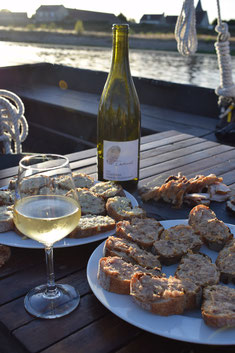The Loire valley wines


The Loire Valley is the third French wine-making region in terms of surface area planted with vines and for the number of bottles of wine sold each year. It produces a great diversity of wines: the Loire can do it all - all colours and all styles of wine, from red to white and rosé, from still to sparkling wine, and from the driest to the sweetest.
This page presents some information about the Loire Valley vineyard and wines but it is impossible to say it all. It will be up to you to come and discover more directly in the vineyard!
The Loire Valley vineyard: history

It is the Romans who introduced vines in the Nantes region about 2000 years ago. Pliny the Elder (23-79 AD) already mentioned vineyards on the banks of the Loire at the beginning of the 1st century.
However the real birth of viticulture in the Loire Valley took place around the 5th century. For the first time, in 582, Bishop
Grégoire de Tours referred to vineyards planted around the towns of Sancerre and Tours. The monks played a major role in the development of the various vineyards. From the Middle Ages until the
mid-19th century, the Loire river was the ideal and main means of transportation for goods, including wines, since the roads were insecure. Therefore the proximity of the river also played an
important part in the development of the vineyard.
It was then the kings and the nobility who contributed to the expansion of the Loire Valley vineyard. Henri II Plantagenêt, Count of Anjou, was crowned King of England in 1154 and imported Anjou
wines to the English court. In Touraine, it was also the kings of France who, when they came to spend time in the Loire Valley and built the châteaux that we know today, contributed to the
development of the vineyard and the planting of new grape varieties. Until the French Revolution, trade with northern Europe intensified, notably thanks to the Dutch.
One key word: diversity

French pupils learn at school that the Loire is the longest river in France, with just over 1000 kilometers, from the source at
Mont-Gerbier-de-Jonc to the estuary in Saint-Nazaire.
This length means that Loire Valley, when it comes to wine-making, is synonymous with diversity: various types of soils, climates, grape varieties, and wines ca be found over the entire 700 km
covered by the vineyard all along the river.
We therefore usually divide the Loire Valley vineyard into 5 major regions:
- the Nantes region (lower Loire), where the famous Muscadet white and dry wines are produced.
- Anjou and Saumurois (part of Middle Loire, with Touraine), known for the sweet and super sweet wines and the semi-dry rosés produced around Angers, and for the sparkling wines and red wines in
Saumur.
- Touraine (the name of the old province around the city of Tours), which produces all colors and styles of wine in a territory spanning the departments of Indre-et-Loire and Loir-et-Cher.
- Central Loire, with AOCs such as Sancerre, Pouilly-Fumé, Ménetou-Salon, Quincy ... specializing in the production of white wines made with Sauvignon Blanc, and for red and rosés wines made with
Pinot Noir .
- the Auvergne vineyard (upper Loire), in the centre of France, which has only 4 AOCs (Saint Pourçain, Côte Roannaise, Côtes d'Auvergne, Côtes du Forez).
AOC Vouvray
Why a focus on Vouvray wines? Because they are what Myriam's husband, Cyril, mostly produces at the family winery.
Vouvray is the name of the village - where Myriam grew up - that gives its name to the AOC (Appellation of Controlled Origin, in other words Denomination of Origin). However 8 villages are included in the delineated area of production and allowed to produce grapes to make Vouvray wines.
Saint Martin of Tours, the father of the Vouvray vineyard

Saint Martin is closely linked to the development of the Vouvray vineyard, even though we think that viticulture in the area is certainly prior to the 4th century (grapevines were surely grown from the 2nd century in the area of Tours, according to objects found during archaeological excavations). Nevertheless, we know that Saint Martin had vines planted on the slopes of Marmoutier to provide wine for mass wine used as medicine for the sick and the elderly. After his death in 397 and throughout the Middle Ages, the monks continued to expand the vineyard.
What are Vouvray wines?
Vouvray wines can only be white wines. This is due to the fact that by AOC law, the vinegrowers are only allowed to grow and use Chenin Blanc grapes. Most of the wines produced
under the name Vouvray are sparkling wines - about 65% of the overall production. However only 10% of the sparkling wines are exported, whereas 2/3 of the still wines are shipped abroad, so as
foreigners, you may have heard more of still wines. The sparkling wines are made using the Traditional Method (actually the Champagne Method but this expression can't legally be used outside of
the Champagne region) and can be Extra Brut, Brut or Demi-Sec.
The still wines range from dry to super sweet, depending on the date of the harvest and how sweet the grapes are. The more sugar in the beginning, the more sugar left in the wine in the end (what is called residual sugars). Whether you like very dry wines or are a sweet tooth, there is a Vouvrau wine for everyone!
